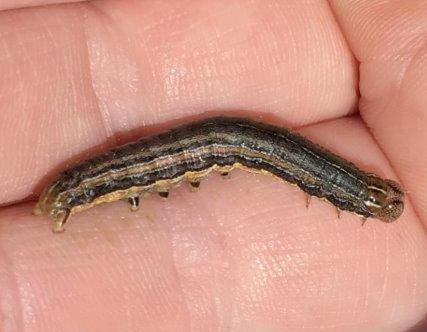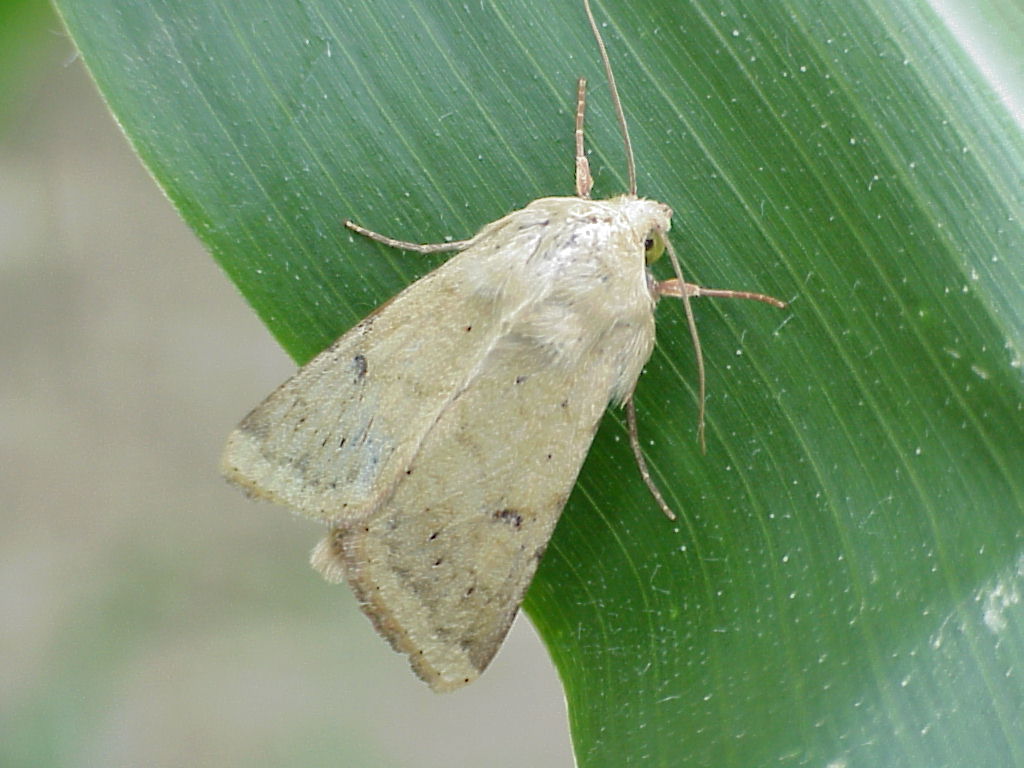Insect Snapshots from the Field
Just a quick overview of some insect issues presenting themselves recently.
True Armyworm
Lots of reports of armyworm being found in wheat and corn. With reports of wheat harvest starting/getting close, reports of armyworm in corn seem to be taking over. I’ve seen a range of larvae stages from 2nd-4th instars. Injury to the whorl and ragged leaf margins is usually noticed around field margins first. Armyworm larvae are night feeders and will usually spend the day in soil cracks, under dirt clods, or in the whorl. Control may be justified when 25% of the plants are being damaged. Things to consider: hot spots in the field and also size of the larvae. Larvae greater than 1 ¼” will have completed most of their feeding.

Corn Rootworm
Reports of lightning bugs in the central part of the state along with degree day accumulations suggest rootworm hatch is underway.
Corn Earworm
We picked up our first corn earworm moth last week. To date, we’ve trapped a total of 10 moths in Champaign. We expect those numbers to slowly pick up over the next couple of weeks.

(Photo courtesy of University of Maine)
Fall Armyworm
A few fall armyworm moths have been picked up in our traps here in Champaign. We expect those numbers to increase in the next few weeks as well.
European Corn Borer
We have yet to pick up any moths in our trap in Champaign. We also have been sampling action sites (dense stands of tall grasses along roadsides ditches or waterways) by making 100 sweeps with a standard insect sweep net. To date, no moths have been recovered in any of the samples statewide.

(Photo courtesy of Marlin Rice)
Stalk Borer
A few reports of stalk borer in corn. These younger larvae did not have the distinct purple “saddle” that we often use to ID these insects. Young larvae will be light brown with a narrow white stripe running down its back from head to tail. There will be a similar white stripe on each side of the body that is interrupted by a purplish-brown band that circles the front third of the body. As larvae get bigger they move from the grass hosts they are quickly outgrowing to larger hosts, such as corn.
Stalk borers will attack corn in 2 different ways:
- Burrow into stalks at ground level and chew upwards through the center of the plant. Wilted leaves will be the first obvious symptom with this injury along with the potential for some plants to buckle at ground level.
- Some larvae may crawl to the top and feed down through the rolled leaves into the stalks. Ragged leaves, along with frass on the leaves may allude to this type of feeding which may also cause wilting of the top half of the plant.
Stink Bugs
I’ve also gotten reports of stink bug injury in southeast Illinois. Stink bug can cause three different types of injury – tillering, stunted plants, and may even kill small seedlings. Signs of stink bug injury will include oval holes where they have inserted their needlelike mouthparts. The stink bug sticks the base of the plant or their leaves with their small needle-like mouth. When they do this, they are causing these plants to die as a small seedling, produce stunted plants- such as misshapen ears instead of tassels- or suckering- the production of tillers form the base of damaged plants. Most often, you see this pest in fields that are no-tillage, near wooded areas, or conventional fields as well as along field edges.
Slugs
Slug injury has been reported across much of southeast Illinois as well and as far north at Livingston county in both corn and soybeans. Slugs are generally a problem in no-till fields; especially if they are late-planted. Slugs take advantage of the smaller plants and as the plants grow, they quickly outpace the slugs. Feeding generally occurs on the lower parts of the plants. Symptoms may resemble that of the corn flea beetle (narrow, irregular tracks or scarring), but the presence of a slime trail will be indicative of the presence of slugs.
Black Cutworm
Once again, we received sustained flights across much of Illinois. Several counties saw repeated significant flights. This map gives you a good indication of projected cutting dates, but several counties like Champaign and Lee saw 4-5 significant flights, so the bottom line is that some of this late planted corn will still be susceptible for BCW injury. Speaking of BCW injury, I have had a few reports of feeding around the state. No indication of anyone area being more severe than another. There is still a lot of small corn across the state that could be susceptible.
Centipedes/Millipedes
I’ve also fielded a few call on centipedes and millipedes last week, though with the warm, dry weather, I don’t suspect to hear much more about these.
Information compiled with the assistance of Kaela Miller, University of Illinois Agriculture Communications.







